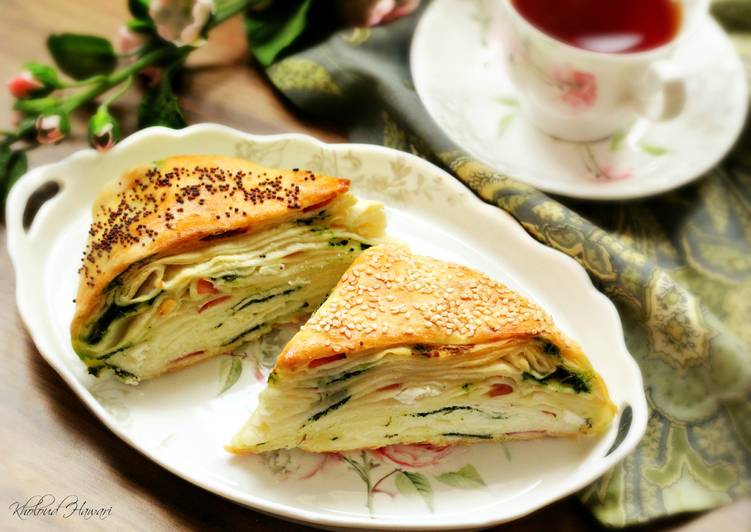Layered Turkish Bread (Borek). Spinach and Feta Layered Turkish Bread (Borek). I love trying out new breads, so when I saw this recipe posted on Gabriela Cara’s blog, I was so excited! It looked wonderful and sounded so unique!
 Thanks to Home Cooking in Montana, I found this new type of bread (new to me) that fills out a soup meal wonderfully. Turkish bread Bazlama is easy to make flatbread baked in a pan. Similar to pita bread but it is a yeast dough with milk and softer. You can have Layered Turkish Bread (Borek) using 11 ingredients and 12 steps. Here is how you achieve it.
Thanks to Home Cooking in Montana, I found this new type of bread (new to me) that fills out a soup meal wonderfully. Turkish bread Bazlama is easy to make flatbread baked in a pan. Similar to pita bread but it is a yeast dough with milk and softer. You can have Layered Turkish Bread (Borek) using 11 ingredients and 12 steps. Here is how you achieve it.
Ingredients of Layered Turkish Bread (Borek)
- Prepare 4 cups of Bread flour all-purpose flour or.
- Prepare 1 1/4 cups of milk Warm ,.
- Prepare as needed of water Warm , get a soft , non - sticky dough.
- You need 1 tbs of yeast Instant.
- You need 1 1/2 tsps of Salt.
- It’s 4 - 6 tbs of Butter , melted.
- It’s 10 - 12 oz of Spinach , chopped , squeezed dry , cooked.
- Prepare 1 cup of Feta cheese.
- It’s 2/3 cup of turkey Smoked , chopped.
- It’s 1 of Egg , beaten.
- It’s of Sesame seeds poppy seeds , and nigella.
Home Cooking In Montana: Spinach and Feta Layered Turkish Bread (Borek). Borek in Turkish cuisine can be considered as a savory pie, but thanks to phyllo sheets, much lighter than it. It is layered with super thin phyllo sheets that are sticked one another with a mixture of yogurt, eggs and olive oil. See more ideas about Turkish recipes, Food and Bread.
Layered Turkish Bread (Borek) step by step
- In a mixing bowl, add flour, salt instant yeast. Stir to combine. Add warm milk and warm water..
- Using a mixer, add dough hook and knead for 10 minutes. Or until soft and pliable. The dough should not stick to the sides of the bowl. Add a little bit of flour if it does stick..
- Take dough out unto an oiled counter top. Cut dough into 6 pieces (if you want to make a larger, one piece borek, or just cut dough into 3 pieces to make 2 boreks)..
- Roll each piece thinly into a rectangle (roughly 17x15 if making 2 boreks.. (when you work with one, Keeping the rest covered so as not to dry out) or roll much bigger if you are doing the larger one piece borek) You basically want to roll it out as thinly as possible, so use hand technique with rolling pin. It is ok if you get some rips(just fix it). Brush with melted butter, sprinkle with half of chopped turkey..
- Roll out second dough piece to the same size. Place on top and brush with melted butter sprinkle half of the chopped spinach and half of feta cheese..
- When you reach the last layer, fold bottom half over the top half. Brush with melted butter..
- Fold the left side to the middle and fold the right side to the middle where the edges touch..
- Turn folded borek seam side down..
- Using a rolling pin, gently roll dough slightly (being careful not to tear the top dough)..
- Place a piece of parchment paper in a 8x8 square pan/dish(or larger if doing the one piece borek). Lightly oil/butter it. Place the folded borek and cut through the dough completely to form triangles..
- Let rise 1 hour in a warm place or until nicely puffed an doubled. Brush with beaten egg, sprinkle sesame seeds/poppy seeds/nigella..
- Bake in a preheated 375 deg. oven for 25-30 minutes or until golden brown..
Borek is a casserole-style layered pie made with yufka sheets and Feta cheese that is a Turkish classic and easy to make. If you’re not in Turkey, you can find packaged yufka in Middle Eastern and Mediterranean grocers. You can also buy it online from websites specializing in Turkish ingredients. Börek (Turkish pronunciation: [bœˈɾec]; also burek and other variants) is a family of baked filled pastries made of a thin flaky dough such as phyllo Recent ethnographic research indicates that börek was probably invented separately by the nomadic Turks of central Asia some time before the seventh. Turkish borek is one of the many foods you should try in Turkey.